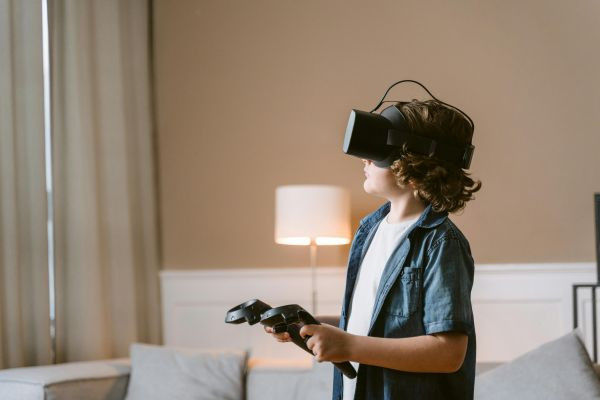Virtual reality has always been considered the future of gaming, promising to envelop players in virtual worlds such as never before.
11/29/24 • 336 Views
The Impact of Virtual Reality on Gaming: Are We Ready for VR's Next Big Leap?
Virtual reality has always been considered the future of gaming, promising to envelop players in virtual worlds such as never before. The time frame for the existence of VR has been in existence for more than a decade, yet the technology itself has recently just matured to a stage that makes it accessible as well as attractive to mainstream groups. With the likes of Meta (previously Facebook), Sony, and HTC pushing the VR to the next big height, do we, by now, need to gear up for VR's biggest move into gaming?
This article will discuss how virtual reality has already impacted the gaming world, the current state of the world of VR gaming, and what the future of this technology holds as it advances.
The Evolution of VR in Gaming:
From its beginnings as an industry, virtual reality has been a gamer's fantasy. The concept of putting all of one's being fully in a game world that actually translates the player's movement and interaction into the environment the gamer is in has been considered fantastic. However, these concepts remained just that concepts throughout the years because they still had limitations in terms of both software and hardware, plus of course, cost.
Early VR Attempts
In the 1990s, Nintendo's Virtual Boy and Sega VR were among the first attempts at creating a virtual gaming experience. These devices were poorly executed, with limited graphics, uncomfortable hardware, and motion sickness issues. VR gaming was relegated to the realm of science fiction for many years.
The Modern VR Era
Fast forward into the 2010s and you start seeing the very first serious, dedicated headsets for playing games on it. In fact, perhaps the largest turning point has been brought about with Facebook's Oculus Rift acquisition and Sony's PlayStation VR in addition to HTC's Vive. These devices gave a preview of the future of immersive gaming but were still limited to high prices, PC requirements, and lack of mainstream content.
Current State of VR Gaming
Currently, VR has developed into something very different from its traditional form. Still, it is quite in its infancy compared to regular gaming. The hardware is far more advanced, including higher resolution displays, better tracking systems, and far more comfortable headsets. The introduction of standalone headsets by platforms such as the Oculus Quest 2 (now Meta Quest 2) has made VR gaming accessible for many without needing a powerful PC or console.
Improvements in VR Technology:
Resolution and Visual Fidelity: These have improved in newer versions to provide sharper displays without much of the screen-door effect (the visible grid of pixels) that used to characterise earlier models. More recent headsets such as Meta Quest 2 and PlayStation VR2 provide resolutions making virtual environments feel so close to reality.
Improved Motion Tracking: Motion tracking has improved significantly, allowing for more fluid and accurate movements. This is particularly important for action-heavy or physically engaging games where tracking your body's movements is essential.
Wireless Freedom: The Meta Quest 2 stands out as a wireless device, which eliminates the need for cables that could restrict your movement. This freedom enhances the immersion, especially for more dynamic gaming experiences.Accessibility and Affordability: The entry cost for VR gaming has dropped dramatically. A device like the Meta Quest 2 is an entry-level experience at a relatively low price, making VR more accessible to gamers who may have once been hesitant about the cost.
Nonetheless, the VR gaming market faces severe challenges. High-end headsets like the HTC Vive Pro 2 or PlayStation VR2 require powerful hardware or consoles to work, making it very expensive for most individuals. Additionally, while there is some exceptional VR content, its general library of engaging VR content remains limited compared to traditional gaming options.
The Future of VR Gaming: Are We Ready for the Next Big Leap?
Virtual reality gaming is on the cusp of several potential breakthroughs that could revolutionize the industry as technology continues to advance. But are we ready for VR's next big leap?
1. Fully Immersive Experiences:
One of the most exciting areas for future VR is developing even more immersive, lifelike experiences. Current VR systems have progressed significantly, but there still are some aspects of immersion that need to be improved upon.
Haptic Feedback: Haptic technology is already being used in some VR controllers to provide physical sensations when interacting with objects in the virtual world. Future advancements in haptic feedback could allow players to feel more complex sensations, like the impact of a sword fight or the sensation of rain hitting their face. Full-body haptic suits could enhance this experience, allowing players to feel their virtual environment on their skin.
2. Social and Multiplayer VR Gaming:
Social VR has an incredible possibility of revolutionizing multiplayer gaming with a kind of social experience that far exceeds any form of entertainment experienced via gaming.
Some social VR spaces: Sites like VRChat already offer people to meet, greet, socialize, or even play together in a virtual world. With advancements in VR technology, we would witness highly interactive social areas like concerts, hanging out, or collaborating in real time.
Multiplayer Games: Many multiplayer games are being adapted for VR, but the next big leap could involve more complex, large-scale multiplayer experiences. Imagine large open-world games like World of Warcraft or Fortnite being playable in VR, where players can move around freely in a fully immersive world, engaging in combat and interacting with others as if they were truly present.
3. VR and Artificial Intelligence (AI):
With the application of AI in VR, comes a more intelligent, more dynamic non-played characters. AI may offer this type of responsiveness within NPCs as they are exposed to real-time response towards players and adaptation and learning behavior patterns. The AI-based procedural world could also ensure the development of an infinite possibility to explore by generating landscapes and quests on the basis of user behavior.
4. Augmented Reality and Mixed Reality integration:
The boundaries between AR and VR are getting more blurred. Wherein, VR will fully immerse players in entirely virtual worlds while AR overlays digital content on the real world. It may bring about mixed reality experiences wherein virtual objects and characters can blend seamlessly into the physical world. For example, we can think of a game played in which your physical setting is part of the virtual world, making for something of a best-of-every-world hybrid experience of both technologies.
Conclusion: Are We Ready?
The next big step in VR gaming is undoubtedly the excitement; it is the latest hardware upgrade, immersive experiences, multiplayer features, and game play guided by AI. Evidently, though this technology has made tremendous headway, there are still great challenges ahead. The route to the next leap for VR hinges on easier access, easing motion sickness, and improving the scale and diversity of their games.
Are we prepared for the next big leap for VR? The answer is yes, but it will take time. As the technology matures and the gaming community buys into its potential, it may well reshape the gaming landscape to deliver experiences that genuinely feel like no other. The question is not if, but when. And with progress on the horizon, it feels like the future of VR gaming is closer than we would have imagined.









